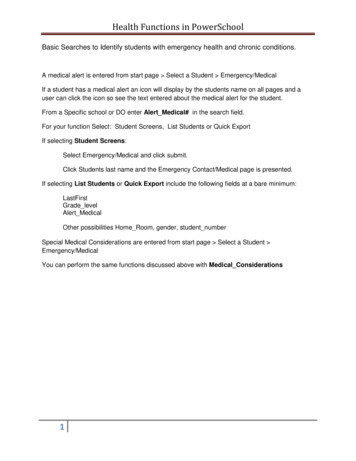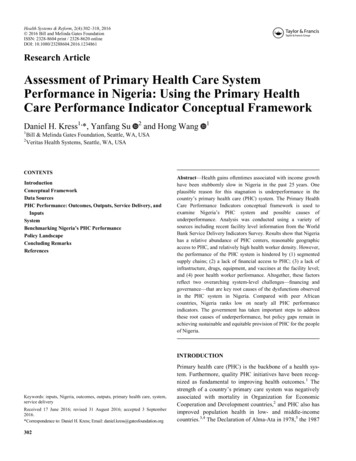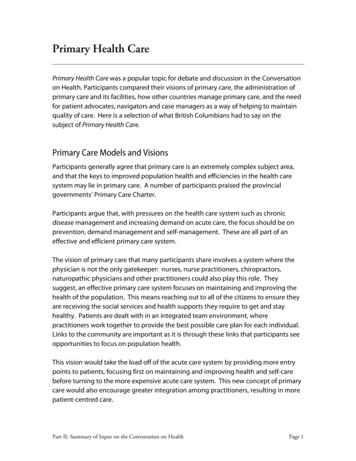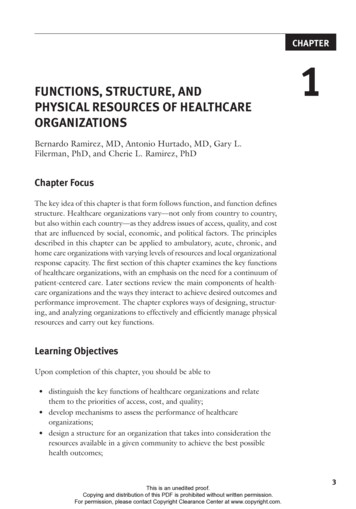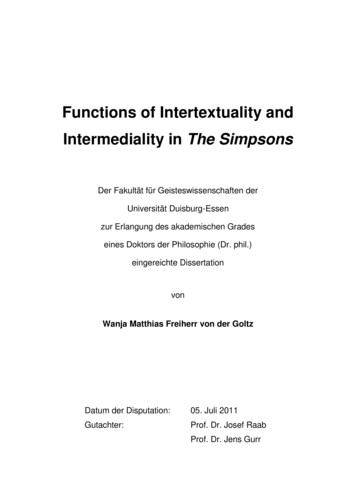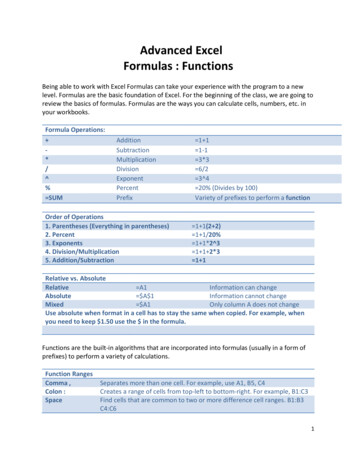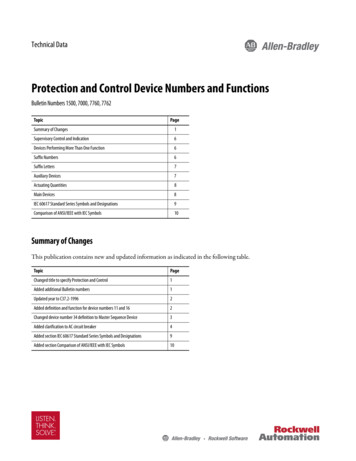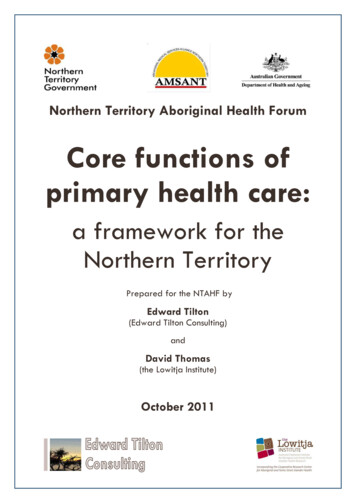
Transcription
Northern Territory Aboriginal Health ForumCore functions ofprimary health care:a framework for theNorthern TerritoryPrepared for the NTAHF byEdward Tilton(Edward Tilton Consulting)andDavid Thomas(the Lowitja Institute)October 2011
STRUCTURE OF THE CORE FUNCTIONS OFPRIMARY HEALTH CARE FRAMEWORK FOR THENORTHERN TERRITORYDomain 1: Clinical ServicesDomain 2: Health PromotionServices delivered to individual clients and/or families, inboth clinic and home / community settings, includingtreatment, prevention and early detection, rehabilitationand recovery, and clinical support systems.Non-clinical measures aimed to improve the health ofthe community as a whole. Health promotion includes arange of activities from building healthy public policy toproviding appropriate health information andeducation, and encourages community developmentapproaches that emphasise community agency andownership.1.1 Treatment1.2 Prevention & early intervention1.3 Rehabilitation and recovery2.1 Building healthy public policy1.4 Clinical support systems2.2 Creating supportiveenvironments2.3 Supporting community actionand developmentDomain 3: Corporate Services &InfrastructureFunctions to support the provision of health services,including the availability and support of well-trainedstaff, financial management, infrastructure, informationtechnology, administration, management and leadership,and systems for quality improvement across theorganisation2.4 Health information, educationand skills development2.5 Orienting health servicestowards health promotion2.6 Evidence and evaluation inhealth promotion3.1 Management and leadership3.2 Workforce and HR management3.3 Staff development, training andeducation3.4 Financial management3.5 Administrative, legal & otherservices3.6 Infrastructure and infrastructuremanagement3.7 Information technology3.8 Quality systemsDOMAIN 4: Advocacy, Knowledge &Research, Policy & PlanningIncludes health advocacy on behalf of individual clients,on local or regional issues, or for system-wide change; theuse of research to inform health service delivery as wellas participation in research projects; and participation inpolicy and planning processes (at the local / regional /Northern Territory and national levels)4.1 Advocacy4.2 Knowledge and research4.3 Policy and planningDomain 5: Community Engagement, Control & Cultural SafetyProcesses to ensure cultural safety throughout the organisation, engagement of individual clients & families with their own health &care, participation of communities in priority setting, program design & delivery, and structures of community control & governance.5.1 Engaging individual clients with their health and care5.2 Supporting community participation5.3 Governance and community control5.4 Cultural safety
ContentsINTRODUCTION . 1DOMAIN 1: CLINICAL SERVICES . 111.1 Treatment. 141.2 Prevention and early intervention . 151.3 Rehabilitation and recovery. 161.4 Clinical support systems . 17DOMAIN 2: HEALTH PROMOTION . 192.1 Building healthy public policy . 222.2 Creating supportive environments . 232.3 Supporting community action and development . 242.4 Health information, education and skills development . 252.5 Orienting health services towards health promotion . 262.6 Evidence and evaluation in health promotion . 27DOMAIN 3: CORPORATE SERVICES AND INFRASTRUCTURE . 293.1 Management and leadership . 323.2 Workforce and HR management . 333.3 Staff development, training and education . 343.4 Financial management . 353.5 Administrative, legal and other services . 363.6 Infrastructure and infrastructure management . 373.7 Information technology. 383.8 Quality systems. 39DOMAIN 4: ADVOCACY, KNOWLEDGE AND RESEARCH, POLICY AND PLANNING . 414.1 Advocacy . 444.2 Knowledge and research . 454.3 Policy and planning . 46DOMAIN 5: COMMUNITY ENGAGEMENT, CONTROL AND CULTURAL SAFETY . 485.1 Engaging individual clients with their health care . 515.2 Supporting community participation . 525.3 Governance and community control . 535.4 Cultural safety . 54SPECIFIC AREAS . 57A. Alcohol, tobacco and other drugs . 58B. Early childhood development and family support . 60C. Aged and disability . 62D. Mental health / social and emotional well being . 64APPENDIX 1: PROJECT METHODOLOGY . 66APPENDIX 2: CONSULTATIONS, GUIDANCE & ADVICE . 68REFERENCES . 70
AcknowledgmentsThe preparation of this Framework would not have been possible without the guidance, adviceand assistance of many people and organisations.The Commonwealth Department of Health and Ageing funded the development of theFramework. The project was carried out under the guidance of a Working Group of the NorthernTerritory Aboriginal Health Forum, including representatives of the Aboriginal Medical ServicesAlliance Northern Territory (AMSANT), the Northern Territory Department of Health, theCommonwealth Department of Health and Ageing, and General Practice Network NorthernTerritory.The Working Group‟s guidance was fundamental to the development of the Framework.Many thanks also to our Technical Advisory Group (Professor Ian Anderson, Professor JudithDwyer, Dr Bev Sibthorpe and Professor Shane Houston) for their invaluable thoughts and advice.We also consulted experienced policy makers, practitioners and researchers in a number offields, including those relating to the areas of alcohol and other drugs, aged and disability,early childhood development / family support, and mental health / social and emotional wellbeing. Their input is gratefully acknowledged.Last – but not least – were the many service provider organisations, government and nongovernment, who took time to talk to us and inform us of their work and their goals. We hopethat this Framework does justice to the scope of their practice and to their aspiration for betterhealth and well-being for Aboriginal people across the Northern Territory.Edward TiltonDavid Thomas
Northern TerritoryAboriginal Health ForumCore Primary Health CareFunctions FrameworkINTRODUCTIONBackgroundAttempts to define a set of core functions of Aboriginal1 primary health care in theNorthern Territory go back to the mid-1990s.At that time, the community controlled health sector was working with the NorthernTerritory and Commonwealth health departments to establish a collaborative andsystematic approach to primary health care planning and delivery. An agreed suite ofcore primary health care functions was seen as important both as a guide to theallocation of resources and to assist in service planning.Over subsequent years there was considerable discussion and refinement of these earlyattempts (see box on right). However these were all, to a greater or lesser extent,partial, because they: focused on clinical services (especially treatmentservices), with less attention to non-clinicalpopulation health approaches or to functions tosupport effective service delivery (corporateservices, community engagement and controletc);focused on health services in the remote context,rather than services to the Aboriginal communityas a whole (a substantial proportion of NorthernTerritory Aboriginal people live in Darwin andsurrounds, or in one of the regional centres ofAlice Springs, Nhulunbuy, Tennant Creek, andKatherine);were written from an explicitly government orcommunity controlled health service perspective;orfocused on access and resourcing issues, ratherthan the comprehensive description of corefunctions.The development of an agreed set of core functionsof primary health care in the Northern Territory wasgiven impetus through the 2008 Federal Budgetannouncement of 99.7 million to expand healthservice delivery in Aboriginal communities, with theroll-out of the funding to be planned collaborativelyby the three Northern Territory Aboriginal HealthForum (NTAHF) partners2.Core functions of primary health care:Key Northern Territory documents Central Australian AboriginalCongress (nd. [1998?]). Aboriginalprimary health care: core functions.Unpublished paper, Alice Springs. Freeman P and Rotem A (1999).Essential Primary Health CareServices for Health Development inRemote Aboriginal Communities in theNorthern Territory, WHO RegionalTraining Centre for HealthDevelopment - University of NewSouth Wales. AMSANT (Aboriginal MedicalServices Alliance Northern Territory)."Administration Manual forAboriginal Primary Health CareServices in the Northern Territory."Retrieved 22 September, 2010, .html. Northern Territory Aboriginal HealthForum (Technical Working Group)(2007). Indigenous access to coreprimary health care services in theNorthern Territory. Centre for Remote Health (2009).Core services across the lifepsan: abrief consultancy conducted by theCentre for Remote Health tocontribute to the ongoing refinementof the DHF Core Primary Health CareServices Initiative. Northern TerritoryDepartment of Health and Families.In this context, an agreed set of core primary health care functions was agreed to beessential to support planning and to direct and underpin decisions about health servicestructures and delivery.Prepared by Edward Tilton Consulting and the Lowitja InstitutePage 1
Core Primary Health CareFunctions FrameworkNorthern TerritoryAboriginal Health ForumWhat is this Framework?This document aims to build on the substantial work in the area of core primary healthcare functions to date, and to bring it together into a comprehensive set of core functionsthat can be agreed by all partners of the NTAHF and be applicable to regionallybased Aboriginal primary health care across the Northern Territory3.This document is therefore a guide to a comprehensive approach to Aboriginal primaryhealth care at a regional level in the Northern Territory that: uses a comprehensive model of primary health care which includes all the functionsnecessary for effective regional comprehensive primary health care services; focuses on the core functions of primary health care delivered or accessedthrough a regional level primary health care service (that is, in terms of the currentreform process, at the Health Service Delivery Area level); and is applicable to all organisations delivering primary health care services toAboriginal communities in the Northern Territory, while taking account of howindividual functions or domains might be implemented under different:o governance structures (community control / government / other)o service structures across a region (dispersed / single location / other)o locations (urban / rural / remote)It is also worth noting what this document is not. It is not: a prescriptive list of functions that all primary health care services „must‟ deliver.Services operate under many constraints including resourcing levels, availability ofstaff and infrastructure quality and availability, and must also take into account localand regional health needs and community priorities4;
DOMAIN 4: Advocacy, Knowledge & Research, Policy & Planning Includes health advocacy on behalf of individual clients, on local or regional issues, or for system-wide change; the use of research to inform health service delivery as well as participation in research projects; and participation in policy and planning processes (at the local / regional / Northern Territory and national levels) 4.1 .

